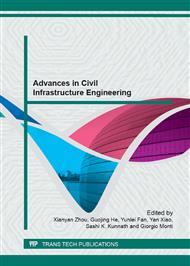p.404
p.411
p.417
p.423
p.429
p.434
p.444
p.452
p.456
Effect of Interface Bond Condition on Airport Double-Layer Pavement Overlay’s Load Stress and Deflection
Abstract:
In order to study the influence of interface bond condition between new and old cement concrete pavement on overlay performance, the three-dimensional finite element model of the airport double-layer pavement was established. The pavement overlay's load stress and deflection were analyzed, the coupling coefficient between new and old cement concrete pavement was calculated based on the bottom of overlay deflection basin shape factor. The results show that the coupling coefficient reflects the degrees of interface bond condition well. Poor interface bond condition increases the overlay's load stress and deflection. The points that more closely distance from the wheels load center, the bigger the pavement overlay's load stress and deflection is. Therefore, more attention should be paid to the interface bond condition during the airport pavement overlay's designs and constructions.
Info:
Periodical:
Pages:
429-433
Citation:
Online since:
January 2013
Authors:
Price:
Сopyright:
© 2013 Trans Tech Publications Ltd. All Rights Reserved
Share:
Citation:


